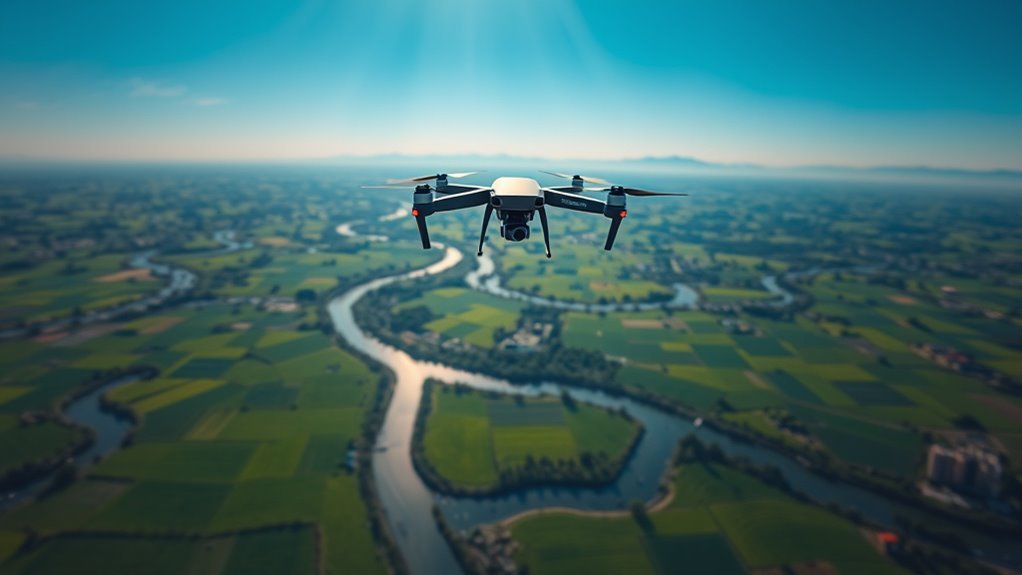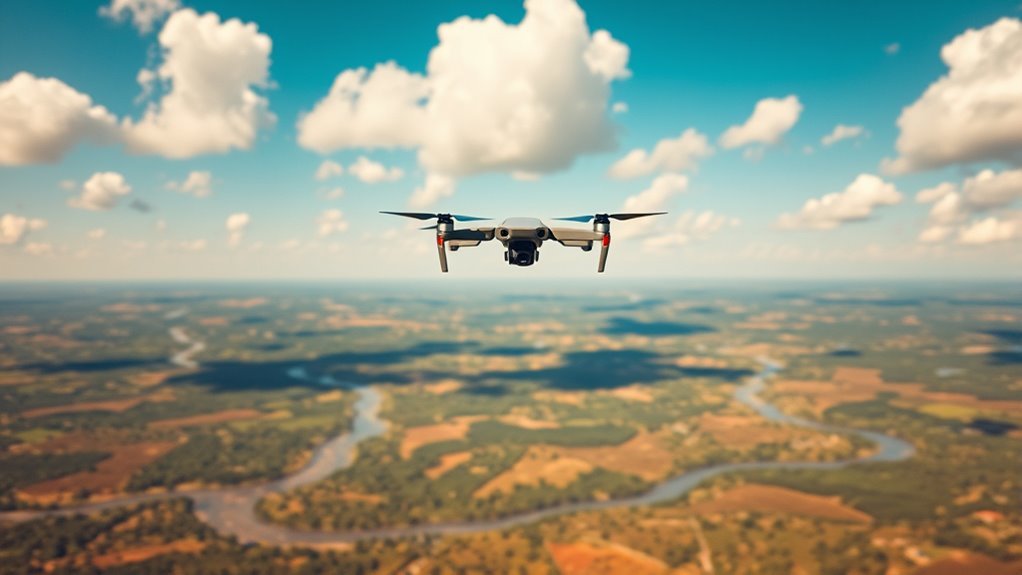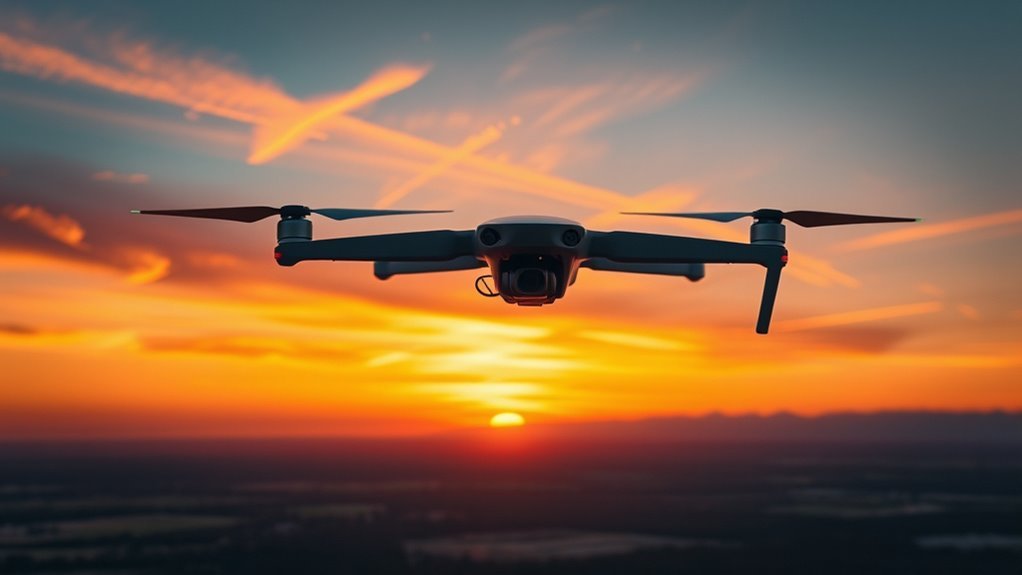Drones can typically fly distances from a few miles to over 40 miles, depending on battery life, weight, and environmental conditions. Battery capacity plays an essential role, as more powerful batteries allow for longer flights. Additionally, factors like weather, terrain, and regulations can greatly impact range. Some advanced models boast superior endurance. If you’re curious about specific drone models or future trends, you’ll find further insights on those topics ahead.
Understanding Drone Flight Range

Understanding drone flight range is vital for optimizing your aerial operations. The distance a drone can effectively travel depends on various factors, including battery life, weight, and environmental conditions. When planning your drone usage, it’s important to evaluate these variables to guarantee compliance with flight regulations, which often dictate operational boundaries. For instance, many regulations require drones to remain within visual line of sight, limiting their effective range. You’ll want to analyze the specific capabilities of your drone model and any applicable laws in your area. By grasping the nuances of flight range, you can enhance your operational efficiency and make informed decisions that maximize your freedom in the skies while adhering to necessary guidelines. For example, understanding flight time and battery performance can greatly influence how far and how long you can fly your drone. Additionally, optimizing weight distribution can significantly impact both stability and flight endurance, leading to improved range.
Factors Affecting Drone Range

When considering the range of your drone, several critical factors come into play. Battery capacity greatly impacts how far your drone can travel, while environmental conditions, such as wind and temperature, can also influence performance. Additionally, the design specifications of your drone, including weight and aerodynamics, are essential to understanding its overall range capabilities. Effective power management is crucial for maximizing flight distance and ensuring efficient energy use during operation. For example, drones like the Autel EVO Lite+ V2, with its larger battery capacity, can achieve extended flight times compared to smaller drones, enhancing their operational range.
Battery Capacity Impact
Battery capacity greatly influences a drone’s range, as it directly determines how long the aircraft can stay airborne before requiring a recharge. Understanding this impact is essential for making informed decisions about your drone’s performance. Several factors come into play:
- Battery management: Efficient management systems can optimize energy use, extending flight time.
- Energy efficiency: The design of the drone affects how well it converts battery power into flight. Aerodynamic shapes and lightweight materials enhance this efficiency.
- Payload weight: Carrying additional weight drains the battery faster, reducing overall range.
Environmental Conditions Influence
Although many might focus solely on technical specifications, environmental conditions greatly affect a drone’s flight range. Factors like weather impact, altitude effects, and temperature variations can markedly influence performance. For instance, high wind resistance decreases efficiency, while humidity levels and atmospheric pressure alter air density, impacting lift. Additionally, terrain challenges and seasonal changes can restrict navigation and battery life, leading to reduced range. Visibility conditions also play a role in flight safety and operational limits.
| Factor | Impact on Flight Range | Example |
|---|---|---|
| Weather Impact | Can reduce visibility and stability | Rain and fog |
| Altitude Effects | Thinner air reduces lift | High elevations |
| Temperature Variations | Extremes can affect battery efficiency | Cold temperatures |
Drone Design Specifications
Drone design specifications play a critical role in determining flight range. When you consider how far your drone can fly, focus on three key factors:
- Drone materials: Lightweight materials enhance endurance, reducing energy consumption during flight.
- Aerodynamic design: A sleek, streamlined shape minimizes drag, allowing for smoother air travel and extending range.
- Battery capacity: Larger batteries provide more energy, but they also add weight, which can decrease overall efficiency.
Each of these elements interacts to define your drone’s performance. Choosing the right combination of materials and design will give you the freedom to explore further distances. By understanding these specifications, you can optimize your drone for maximum flight range, enhancing your aerial adventures.
Battery Life and Its Impact

Battery life directly influences your drone’s operational range and flight capabilities. By comparing different battery types, you can assess their impact on flight time and overall performance. Additionally, understanding range extension techniques can help you maximize your drone’s efficiency during longer missions. Implementing efficient flying techniques can further enhance power efficiency and aerodynamics, allowing for extended flight durations. For instance, the DJI Mavic 3 Enterprise showcases superior battery technology, providing longer flight times compared to many competitors.
Battery Types Comparison
As you evaluate the various battery types available for drones, it becomes essential to understand how each one affects overall flight performance and distance. Different batteries offer distinct advantages and limitations:
- Lithium Polymer (LiPo): Known for high energy density and lightweight, LiPo batteries provide longer flight times, ideal for extended missions.
- Nickel Cadmium (NiCd): While robust and durable, NiCd batteries tend to have lower energy density and can suffer from memory effect, limiting their effective capacity.
- Lithium-Ion (Li-Ion): Offering a balance between weight and performance, Li-Ion batteries are suitable for drones needing moderate flight durations.
Choosing the right battery type is vital for maximizing your drone’s capabilities and ensuring it can cover the distances you desire.
Flight Time Factors
While various factors influence flight time, battery life stands out as a critical determinant of how far and long your drone can operate. A drone’s battery capacity directly affects its endurance; higher-capacity batteries typically offer longer flight times. However, battery weight and drone maintenance also play significant roles. Under-maintained drones may experience reduced efficiency, leading to shorter flight durations and potential safety risks. Additionally, operating conditions like temperature and wind can impact battery performance, affecting overall flight safety. Understanding these dynamics allows you to maximize your drone’s capabilities. By prioritizing proper maintenance and selecting the right battery, you can enhance your drone’s flight time, granting you greater freedom to explore the skies.
Range Extension Techniques
To maximize your drone’s range, understanding and implementing effective battery life extension techniques is essential. By optimizing battery usage, you can greatly enhance your drone’s operational distance. Consider employing the following strategies:
- Use range boosters: These devices enhance signal strength, allowing your drone to travel farther without losing connection.
- Install signal repeaters: Strategically placed repeaters can maintain communication with your drone, enabling it to explore extended areas.
- Optimize flight patterns: Adjusting altitude and speed can reduce energy consumption, prolonging battery life during flights.
Weight Considerations
Understanding weight considerations is vital when evaluating a drone’s flight distance, since the total weight directly impacts its lift capacity and battery efficiency. The drone payload, including any attached equipment, must be optimized for maximum efficiency. A heavier payload can dramatically reduce your drone’s flight time, as it requires more energy to lift. Additionally, proper weight distribution is important; unevenly distributed weight can lead to unstable flight and reduced control. When planning your drone’s mission, consider both the payload and the overall weight to guarantee the drone operates within its designed limits. Balancing these factors not only enhances flight performance but also expands your operational range, giving you the freedom to explore further. Proper payload distribution minimizes drag and enhances stability, further extending your drone’s effective distance. The battery capacity plays a crucial role in determining how far a drone can fly, as higher capacity batteries allow for longer flight durations before requiring a recharge.
Environmental Influences
Although environmental factors might seem secondary to a drone’s design, they greatly affect flight distance and performance. Various elements can hinder or enhance your drone’s capabilities, such as:
Environmental factors, often overlooked, significantly impact a drone’s flight distance and performance, shaping its capabilities in the skies.
- Weather patterns: High winds and precipitation can increase wind resistance and affect stability. Additionally, environmental conditions significantly influence battery efficiency and overall flight time.
- Terrain types: Flying over rugged landscapes may require more energy, limiting range.
- Air density and humidity levels: These factors influence lift; lower air density at higher altitudes can reduce performance.
Temperature effects also play a role, as extreme heat or cold can impact battery life. Additionally, electromagnetic interference in urban environments and wildlife interactions can create obstacles. Understanding these influences will help you maximize your drone’s potential and freedom in the skies. Moreover, considering wind resistance capabilities can inform your choice of drone for specific environmental conditions.
Technology Advancements in Drone Flight
As drone technology evolves, you’ll find that advancements in materials, battery life, and navigation systems greatly enhance flight distance and overall performance. Modern drone propulsion systems utilize lightweight composites and high-energy-density batteries, enabling longer missions without sacrificing power. Enhanced flight stability is achieved through sophisticated algorithms and sensors that adapt in real-time to changing conditions, ensuring smooth operation even in turbulent environments. These technological breakthroughs allow you to explore vast areas with confidence, knowing your drone can handle various terrains and weather patterns. Additionally, improved GPS and obstacle avoidance technologies empower you to navigate complex landscapes effortlessly, expanding your freedom to capture stunning aerial footage or conduct inspections over greater distances. Embrace these innovations, and elevate your drone experience. Moreover, features like collision avoidance systems enhance safety while maximizing operational range. Furthermore, drones like the Draganfly utilize advanced battery technology to optimize power usage, extending flight time significantly.
Comparison of Popular Drone Models
With advancements in drone technology setting the stage, comparing popular drone models reveals significant differences in flight distance, battery life, and overall capabilities. Understanding these differences requires a focus on drone performance metrics and flight stability analysis. Here are three models worth considering:
Advancements in drone technology highlight key differences in flight distance, battery life, and overall performance among popular models.
- Model A: Offers impressive flight distances up to 7 miles, with enhanced battery life lasting up to 30 minutes.
- Model B: Prioritizes flight stability, featuring advanced stabilization systems that guarantee smooth operation even in windy conditions.
- Model C: Balances performance and cost, achieving moderate flight distances while providing decent battery longevity. Additionally, the Autel EVO Lite+ V2 showcases superior flight endurance, achieving up to 40 minutes of flight time.
Long-Range Drones on the Market
An increasing number of long-range drones are entering the market, designed to cater to enthusiasts and professionals seeking extended flight capabilities. These drones vary considerably in drone types, including fixed-wing models optimized for endurance and multi-rotor designs focusing on stability and flexibility. For instance, some high-end fixed-wing drones boast long range capabilities exceeding 100 miles, while advanced multi-rotors can achieve ranges around 10-20 miles. Features like enhanced battery technology, efficient propulsion systems, and real-time data transmission are critical for maximizing distance. When selecting a long-range drone, consider factors such as payload capacity, flight time, and control range. Ultimately, understanding these elements empowers you to choose the drone that best aligns with your specific needs and aspirations for aerial freedom. Additionally, the battery efficiency of drones like the Anzu Raptor T can significantly enhance operational capabilities during extended missions. Moreover, drones like the Teal 2 provide robust connectivity options that enable real-time data access even in remote regions, further extending their operational range.
Future Trends in Drone Technology
As you explore future trends in drone technology, you’ll notice significant advancements in enhanced battery life, AI navigation systems, and long-range communication technologies. These innovations will not only extend operational capabilities but also improve the efficiency and reliability of drone missions. Understanding these developments is essential for maximizing the potential of drone applications across various industries. Additionally, AI-driven choreography innovations will enable drones to perform dynamic and synchronized aerial displays, enhancing entertainment experiences and broadening their applications.
Enhanced Battery Life
Although advancements in drone technology have greatly improved flight capabilities, the quest for enhanced battery life remains essential for maximizing operational efficiency. As you explore future trends, consider the following innovations that promise to revolutionize drone endurance:
- Solar charging: Integrating photovoltaic cells can harness sunlight, allowing drones to recharge during flight.
- Battery optimization: Developing smarter algorithms helps manage power consumption, maximizing flight time without compromising performance.
- Next-gen materials: Research into lithium-sulfur and solid-state batteries could lead to lighter, more energy-dense solutions.
AI Navigation Systems
While traditional navigation systems rely heavily on GPS and pre-programmed routes, AI navigation systems are set to transform drone operations by enabling real-time decision-making and adaptive pathfinding. With advancements in machine learning, drones can greatly enhance AI performance, improving navigation accuracy and obstacle avoidance. By integrating various sensors, these systems gather real-time data, allowing for dynamic flight planning and path optimization. Decision-making algorithms process this information swiftly, enabling autonomous flying that adapts to environmental changes. This technology not only increases efficiency but also expands the potential applications of drones, from delivery services to search and rescue missions. As AI navigation systems evolve, they’ll redefine the boundaries of what drones can achieve in increasingly complex environments.
Long-Range Communication Technologies
To maintain control over drones operating at extended distances, the development of long-range communication technologies is essential. These technologies enhance connectivity, ensuring that your drone remains responsive even in remote areas. Key innovations include:
- Satellite communication: Enables real-time data transfer over vast distances, vital for global operations.
- Radio frequency: Offers reliable connectivity with lower latency, ideal for immediate control in various environments.
- Mesh networking: Allows drones to communicate with each other, extending the operational range through collaborative relay systems.
As you explore these advancements, you’ll find they not only increase the operational range but also enhance the autonomy of drones, empowering you to push boundaries like never before. This evolution in communication technology holds the promise of unprecedented freedom in drone missions.
Regulations and Their Effect on Range
As drone technology advances, regulations imposed by aviation authorities greatly influence the operational range of these devices. You’re likely aware that drone regulations often set legal limitations on flight altitude, distance from the operator, and no-fly zones. These constraints can markedly restrict your ability to maximize a drone’s potential. For instance, if you’re operating in a congested area, you might face stricter limitations than if you were in a rural setting. Additionally, compliance with visual line-of-sight rules can hinder long-range operations. While these regulations aim to guarantee safety, they can also stifle innovation and exploration. Understanding these legal frameworks is essential for anyone looking to push the boundaries of drone capabilities while remaining within the confines of the law.
Frequently Asked Questions
Can Drones Fly in Heavy Rain or Snow?
Imagine a bird maneuvering through a storm. Drones struggle in heavy rain or snow, where flight safety becomes compromised. When considering drone weather, you should prioritize conditions to guarantee reliable and efficient performance.
Do Drone Ranges Vary by Model and Brand?
Yes, drone ranges do vary greatly by model and brand. Factors like drone specifications and battery capacity directly influence performance, impacting how far you can fly. Understanding these elements helps you choose the best drone for your needs.
How Can I Extend My Drone’s Flight Range?
Imagine you’re flying a drone for a scenic shoot. To extend its range, consider battery upgrades for more power and signal boosters to enhance connectivity. These improvements can greatly increase your drone’s operational distance and versatility.
Are There Any Altitude Limits for Drones?
Yes, there are altitude limits for drones, typically set by altitude regulations. It’s essential to adhere to these for altitude safety. Ignoring them could compromise your flight experience and lead to potential legal issues.
What Happens if a Drone Flies Out of Range?
If you fly a drone out of range, GPS loss occurs, resulting in drone recovery challenges. It may either return home automatically or crash, emphasizing the importance of maintaining operational boundaries for safety and control.

